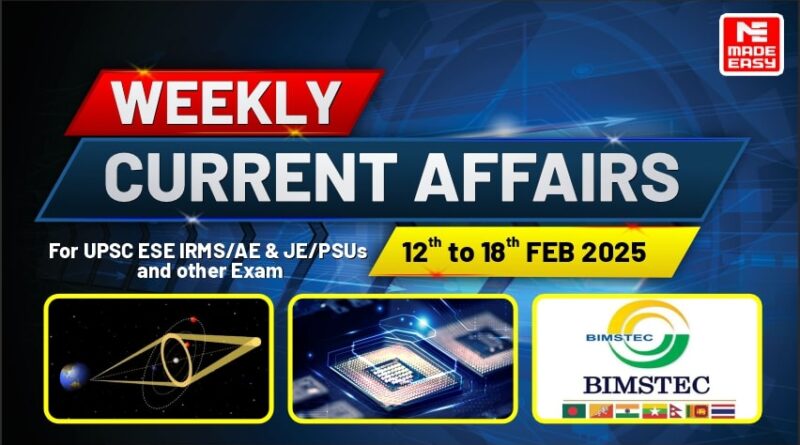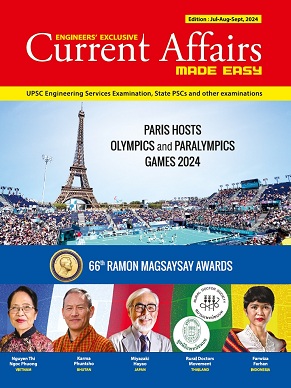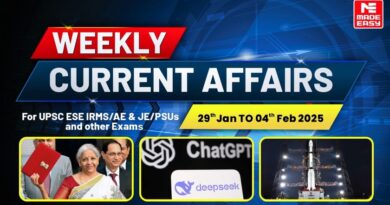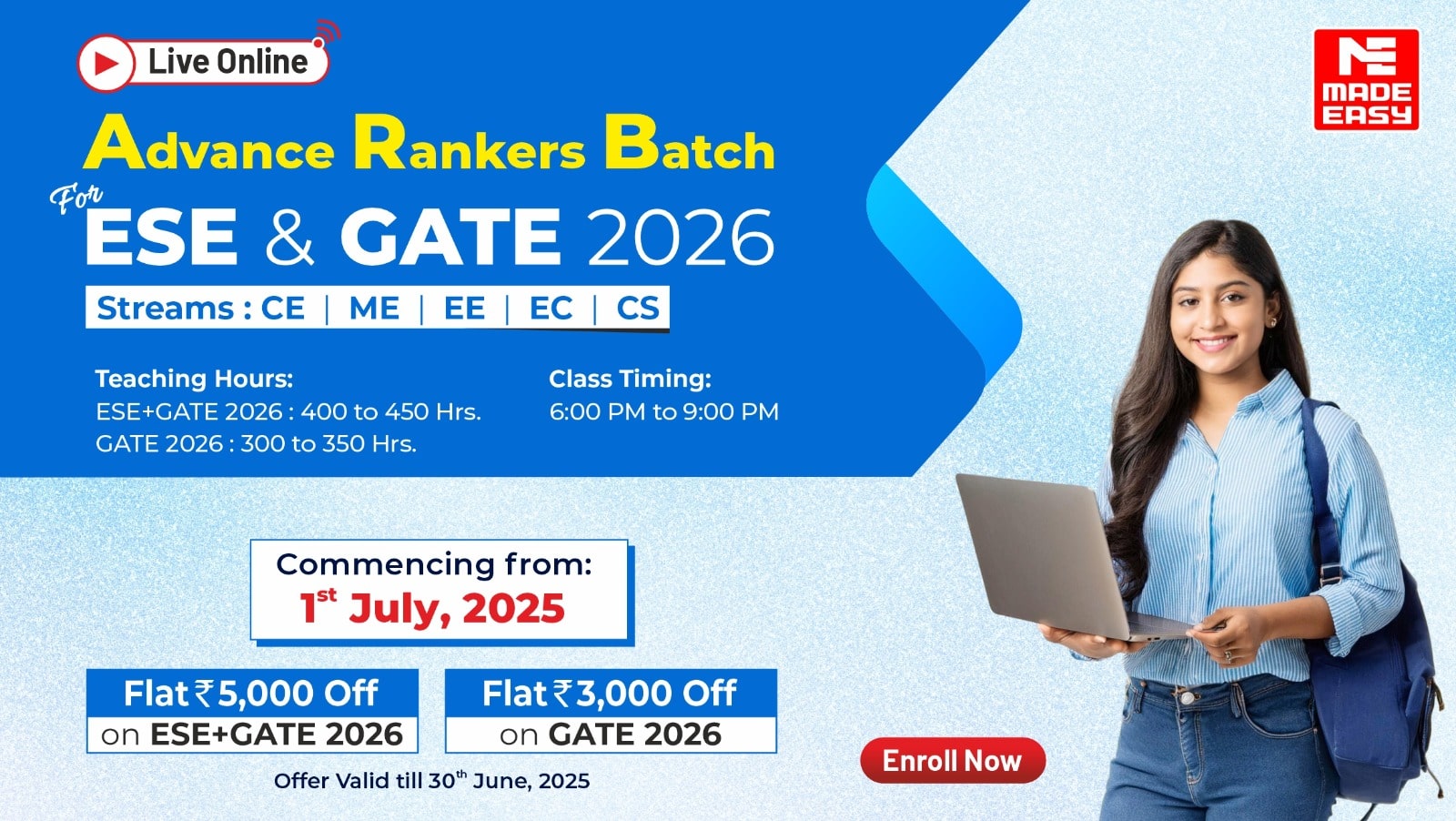Weekly Current Affairs: 12th to 18th February 2025
MADE EASY Week Current Affairs for UPSC ESE, SSC JE, RRB JE & Other Exams
For candidates preparing for government exams in India, such as UPPSC ESE, SSC JE, RRB JE, UPPSC AE, and other competitive exams, staying updated with current affairs is essential. This section is frequently included in both technical and non-technical exams to assess general awareness.
Recognizing its importance, MADE EASY Coaching Institute presents the Weekly Current Affairs (February 12–18, 2025) to help you stay updated with the latest developments. Regular practice and a strong grasp of current affairs can significantly enhance your exam performance. Stay informed and exam-ready with MADE EASY!
In this edition of MADE EASY Last Week Current Affairs, you will read about: Corruption Perceptions Index (CPI) 2024, Gross Domestic Knowledge Product (GDKP), BIMSTEC Youth Summit, Einstein Ring, World’s 1st Hybrid Quantum Supercomputer, Shakti Semiconductor Chip, Einstein Ring, World’s 1st Hybrid Quantum Supercomputer, Shakti Semiconductor Chip, Income Tax Bill 2025, President’s Rule in Manipur, Prime Minister Dhan-Dhaanya Krishi Yojana (PMDKY), U.S.-India TRUST Initiative, NAMASTE Scheme, Munich Security Conference, 2025, Project Waterworth, Bharat Tex 2025, Exercise Komodo, SAKSHAM Campaign, Gyanesh Kumar, National Geospatial Knowledge-based Land Survey of Urban Habitations (NAKSHA) and much more!
Understanding these key topics will enhance your Current Affairs score. Stay updated and strengthen your exam preparation with MADE EASY!
5 to 11 February 2025 Weekly Current Affairs for UPSC CSE, ESE, RRB & SSC JE
Corruption Perceptions Index (CPI) 2024: 12 February 2025
Context: India ranked 96 out of 180 countries in the Corruption Perceptions Index (CPI) for 2024.
Key Highlights
- The Corruption Perceptions Index (CPI) 2024 highlights how corruption is hindering global efforts to combat climate change.
- The index ranks 180 countries and territories by their perceived levels of public sector corruption.
- It uses a scale of zero to 100, where “zero” is highly corrupt and “100” is very clean.
- The report has been compiled by Transparency International.
- 85% of the world’s population lives in countries with CPI scores below 50.
- India scored 38 out of 100, dropping one point from 2023, and ranked 96th.
- Least Corrupt Countries: Denmark, Finland, Singapore.
- Most Corrupt Countries: South Sudan, Somalia, Venezuela.
Gross Domestic Knowledge Product (GDKP): 12 February 2025
Context: The Ministry of Statistics and Programme Implementation (MoSPI) held a session on the Conceptual Framework of Gross Domestic Knowledge Product (GDKP)
Key Highlights
- The initiative aims to quantify the impact of knowledge, innovation, and intellectual assets on India’s economic and social landscape.
- GDKP could provide a more holistic picture of economic growth driven by research, innovation, and technology.
About Gross Domestic Knowledge Product (GDKP)
- The concept of GDKP was first propounded by Prof. Umberto Sulpasso of the University of Southern California along with Prof. Jeff Cole.
- It is a proposed metric designed to measure the knowledge generated and utilized within an economy and serve as a supplementary indicator to GDP.
- GDKP evaluates a nation’s growth and future using four fundamental pillars:
- Knowledge Items (Ki):Identifying modern and traditional cultural knowledge that contributes to the country’s intellectual capital.
- Country’s Knowledge Producing Matrix (CKPM):Analyzing knowledge produced by government institutions, private organizations, and households.
- Country’s Knowledge User Matrix (CKUM):Measuring the value of knowledge purchased by individuals and private entities, reflecting its demand and practical application.
- Cost of Learning:Similar to the cost of living, this metric is proposed as a political reference point for government budget allocations and policy decisions.
BIMSTEC Youth Summit: 12 February 2025
Context: India hosted the 1st BIMSTEC Youth Summit in Gandhinagar, Gujarat
Key Highlights
- It is organized by India’s Ministry of Youth Affairs & Sports, Ministry of External Affairs, and CII YI as the knowledge partner.
- It brings together over 70 young leaders from the seven BIMSTEC countries (Bangladesh, Bhutan, India, Myanmar, Nepal, Sri Lanka, and Thailand) to discuss challenges and opportunities in areas such as entrepreneurship, technology, digital connectivity, and sustainable development.
- The theme, “Youth as a bridge for intra-BIMSTEC exchange,” focuses on empowering youth to address regional issues and collaborate on solutions for a better future.
- Itaims to foster youth engagement and development in the region, aligning with India’s “Neighborhood First” and “Act East” policies, and its vision for regional security and growth (SAGAR).
- The Bay of Bengal Initiative for Multi-Sectoral Technical and Economic Cooperation (BIMSTEC) was established in 1997 with the signing of the Bangkok Declaration.
- Initially called BIST-EC (Bangladesh-India-Sri Lanka-Thailand Economic Cooperation), it later expanded to include Myanmar in December 1997 and Bhutan and Nepal in 2004, changing its name to BIMSTEC.
- Initially focused on six sectors (trade, technology, energy, transport, tourism, fisheries), cooperation expanded in 2008 to include agriculture, health, poverty alleviation, counter-terrorism, environment, culture, people-to-people contact, and climate change.
Einstein Ring: 13 February 2025
Context: The European Space Agency’s (ESA) Euclid space telescope has discovered an Einstein ring, around a galaxy nearly 590 million light-years away from Earth.
About Einstein Ring
- An Einstein ring is a circular formation of light caused by gravitational lensing, where a massive celestial object bends and magnifies light from a more distant object behind it.
- Gravitational lensing is an example of Einstein’s theory of general relativity.
- Lensing Effect: If the alignment between the observer, the foreground lens, and the background source is nearly perfect, the light from the background galaxy can be smeared into a ring.
- In the recently observed Einstein ring, the galaxy NGC 6505 acted as the gravitational lens.
Significance
- Probing Dark Matter: Dark matter, which makes up 85% of the universe’s total matter, does not emit or absorb light, making it difficult to observe directly.
- Einstein rings provide indirect evidence of dark matter’s gravitational influence.
- Understanding Distant Galaxies: These rings help scientists study galaxies that would otherwise be too faint or distant to observe.
- Insights into Cosmic Expansion: The bending of light provides crucial data about the expansion of the universe, as the space between celestial bodies is continuously stretching.
World’s 1st Hybrid Quantum Supercomputer: 13 February 2025
Context: Engineers in Japan have successfully activated Reimei, the world’s first hybrid quantum supercomputer.
Key Facts
- The 20-qubit quantum computer has been seamlessly integrated into Fugaku, the world’s sixth-fastest supercomputer, marking a significant milestone in high-performance computing.
- Unlike most quantum computers that rely on superconducting qubits, Reimei utilizes trapped-ion qubits—a technology that isolates charged atoms (ions) in an electromagnetic ion trap and uses lasers to precisely manipulate their quantum states.
- The integration of Reimei into Fugaku aims to tackle complex calculations that traditional supercomputers struggle with, particularly in physics and chemistry research.
Shakti Semiconductor Chip: 13 February 2025
Context: IIT Madras & ISRO has developed SHAKTI-based semiconductor chip.
Key Highlights
- The chip, named IRIS (Indigenous RISC-V Controller for Space Applications), is based on the SHAKTI microprocessor.
- SHAKTI systems use RISC-V, an open-source processor technology, and are supported by the Ministry of Electronics and Information Technology under the ‘Digital India RISC-V’ (DIRV) initiative.
- This development marks a significant step toward self-reliance in space and semiconductor technology.
- It is designed for fault tolerance and reliability, making it suitable for space missions.
Income Tax Bill 2025: 14 February 2025
Context: The government has proposed a new bill to repeal and replace the 60-year-old Income Tax Act, 1961, with a simpler and more efficient tax framework.
Key Highlights
- Income Tax Bill 2025 aims to simplify Income Tax Act 1961. The new bill reduces chapters and words for enhanced clarity.
- It aims to reduce litigation and enhance compliance. Once passed, the proposed legislation will be called the Income Tax Act, 2025, and is expected to take effect in April 2026.
Features
- Qualitative Improvements
- Simplified language, making the law more accessible.
- Consolidation of amendments, reducing fragmentation.
- Removal of obsolete and redundant provisions for greater clarity.
- Structural rationalization through tables and formulae for improved readability.
- Preservation of existing taxation principles, ensuring continuity while enhancing usability.
- Crypto as Property: Virtual digital assets such as cryptocurrencies have been included in the definition of property to be counted as a capital asset.
- Dispute Resolution: It provides the points of determination, decision, and the reasons behind it, marking a shift from the earlier section, which lacked clarity on the manner of issuing DRP directions.
- Capital Gain Exemptions: Section 54E of the Act, which details exemptions for capital gains on transfer of capital assets prior to April 1992 has been removed.
- Tax Year: The Bill introduces the concept of “tax year”, which has been defined as the 12-month period beginning April 1.
President’s Rule in Manipur: 14 February 2025
Context: The Ministry of Home Affairs (MHA) has announced the imposition of President’s Rule in Manipur, with the state assembly placed under suspended animation.
Constitutional Provisions
- Article 356 empowers the President of India to impose President’s Rule in a state when governance cannot be carried out as per constitutional provisions.
- Grounds: If the President receives a report from the state’s Governor or otherwise is convinced or satisfied that the state’s situation is such that the state government cannot carry on the governance according to the provisions of the Constitution.
- Under the President’s rule, the elected state government is dismissed and its powers are suspended.
- The Governor becomes the executive head of the state and runs the administration on behalf of the President.
- The proclamation remains valid for up to two months but must be approved by both Houses of Parliament to extend further.
- If approved, the Rule can last for six months and be extended in increments of six months, up to a maximum of three years.
Prime Minister Dhan-Dhaanya Krishi Yojana (PMDKY): 15 February 2025
Context: The Union Finance Minister while presenting the Union Budget announced the launch of the Prime Minister Dhan-Dhaanya Krishi Yojana (PMDKY).
Key Highlights
- PMDKY will cover 100 districts based on three broad parameters: low productivity, moderate crop intensity, and below-average credit parameters.
- Cropping intensity is a measure of how efficiently land is used, and it is defined as the percentage of the gross cropped area to the net area sown.
- Aims:
- Enhance agricultural productivity;
- Adopt crop diversification and sustainable agricultural practices;
- Augment post-harvest storage at panchayat and block level;
- Improve irrigation facilities;
- Facilitate availability of long- and short-term credit.
- Under this scheme, 1.7 crore farmers will receive support. The scheme will be implemented in partnership with state governments.
- Benefits: Provides quality seeds, fertilizers, and chemicals to boost crop production.
U.S.-India TRUST Initiative: 15 February 2025
Context: India and the US have launched the “Transforming Relationship Utilizing Strategic Technology” (TRUST) initiative.
About TRUST Initiative
- It builds on national programs like the US Critical Minerals and Materials (CMM) program and India’s National Critical Minerals Mission to boost exploration, recycling, and R&D in critical minerals.
- It focuses on cooperation in the recovery and processing of critical minerals, including lithium and rare earth elements (REEs).
- It aims to reduce barriers to technology transfer, address export controls, and enhance high-tech commerce between the two countries, particularly in critical minerals and advanced materials.
- It will promote collaboration among governments, academia, and the private sector to drive innovation in sectors like defense, AI, semiconductors, quantum computing, biotechnology, energy, and space. It aims to counter China’s dominance in critical minerals supply chains.
NAMASTE Scheme: 15 February 2025
Context: The distribution of PPE kits and Ayushman health cards under the NAMASTE scheme is a crucial step towards ensuring dignity, safety, and social empowerment of Safai Mitras.
About NAMASTE Scheme
- Objectives: Eradicate manual scavenging by promoting mechanized sanitation.
- Enhance the safety and dignity of sewer & septic tank workers.
- Formalize the workforce and provide skill development opportunities.
- Implemented by: Ministry of Social Justice and Empowerment (MoSJE) & Ministry of Housing and Urban Affairs (MoHUA)
- Implementation Timeline: FY 2023-24 to 2025-26 (3 years).
- Target Group: Initially focused on sewer and septic tank workers (SSWs).
- Waste-pickers were added in 2024 to further expand coverage.
Munich Security Conference, 2025: 16 February 2025
Context: Recent developments at the 61st Munich Security Conference (MSC) have brought into light shift in the geopolitical landscape between the United States and Europe.
Key Highlights
- With the ongoing war in Ukraine, the absence of Ukrainian representatives from crucial negotiations has raised concerns about the future of European security and unity.
- The conflict in Ukraine has led to a reassessment of Western policies.
- Current NATO spending guidelines may rise from 2% to 3% of GDP. This is in response to Russia’s increased military budget, which exceeds European spending.
- The conference exposed rifts between US and European policies.
- Simultaneously, former President Donald Trump announced plans for tariffs on steel and aluminium imports. This has further complicated the relationship, as European leaders strive to maintain strong ties with both the US and the EU.
About Munich Security Conference
- The Munich Security Conference has evolved since its inception in 1963.
- Originally focused on military issues, it now addresses various global challenges, including climate change and migration.
- The conference aims to encourage dialogue among international security stakeholders.
Project Waterworth: 16 February 2025
Context: Meta has announced an ambitious undersea cable initiative called Project Waterworth to enhance global digital connectivity.
About Project Waterworth
- It is an AI-powered subsea cable system, spanning 50,000 km across five continents and is the longest and highest-capacity subsea cable system, linking the U.S., India, Brazil, South Africa, and other key regions.
- The cables will be laid at depths of up to 7,000 meters in deep waters and advanced burial techniques in high-risk shallow waters will protect the cables from ship anchors and environmental hazards.
- The initiative will introduce three new oceanic corridors, improving the scale and reliability of internet networks.
- Greater connectivity will enhance international cooperation, digital inclusion, and technological advancements.
Bharat Tex 2025: 17 February 2025
Context: Bharat Tex 2025, a global textile event held in New Delhi from February 14 to 17, 2025.
Key Highlights
- During this event, Prime Minister Narendra Modi announced ambitious targets for India’s textile exports, aiming to increase from ₹3 lakh crore to ₹9 lakh crore by 2030.
- Bharat Tex 2025 is the second edition of an annual exhibition organised by 12 export promotion councils and supported by the Ministry of Textiles.
- The event features over 5,000 exhibitors and aims to consolidate India’s textile capabilities on a global platform. The exhibition spans 2.2 million square feet, showcasing a variety of products from raw materials to finished goods.
- Notable countries represented include Japan, the UAE, and the USA. The presence of global brands and retail chains puts stress on India’s position as a key player in the textile industry.
- The exhibition marks innovations such as organic fabrics and energy-efficient production technologies. Various projects funded by the European Union aim to enhance sustainability and promote women’s economic empowerment within the textile sector.
- Bharat Tex 2025 features over 70 conference sessions, roundtables, and master classes. Topics include global trade shifts, technical textiles, and AI-driven manufacturing.
Exercise Komodo: 17 February 2025
Context: The Indian Navy, represented by INS Shardul and P8I Long Range Maritime Surveillance aircraft, is actively participating in Exercise Komodo 2025.
About Exercise Komodo
- First launched in 2014, it is a non-combat military exercise aimed at fostering maritime cooperation among friendly nations.
- It is a multilateral naval exercise hosted by the Indonesian Navy in Bali, Indonesia.
- This aligns with India’s SAGAR (Security and Growth for All in the Region) vision, strengthening maritime partnerships in the Indo-Pacific.
- Enhanced interoperability with ASEAN Navies and QUAD partners.
SAKSHAM Campaign: 17 February 2025
Context: Indian Oil Corporation Limited and Bharat Petroleum Corporation Limited launched a 14-day awareness campaign called SAKSHAM.
Key Highlights
- The campaign was launched on green energy and fuel conservation.
- It aims to raise awareness about fuel conservation and the judicious use of petroleum products to ensure a safer environment and sustainable energy resources for future generations.
- The idea is to convince consumers to switch to cleaner fuels and bring in behavioural change to use fossil fuel intelligently.
Gyanesh Kumar: 18 February 2025
Context: Former IAS officer Gyanesh Kumar has been appointed as the Chief Election Commissioner (CEC) of India, succeeding Rajiv Kumar.
Key Facts
- The appointment was made by a Selection Committee comprising Prime Minister Narendra Modi, Home Minister Amit Shah, and Leader of Opposition Rahul Gandhi.
- The process has sparked controversy due to opposition objections and pending Supreme Court cases.
- Previous system of appointment:
- The Election Commission of India (ECI) comprises a CEC and two Election Commissioners (ECs).
- Earlier, there was no law passed by Parliament for the appointment of the CEC and ECs. The President appointed the CEC on the advice of the Prime Minister.
- Traditionally, the senior-most Election Commissioner was elevated to CEC.
- Seniority was determined based on the order of appointment notification.
- The new appointment process:
- The Chief Election Commissioner And Other Election Commissioners (Appointment, Conditions of Service And Term of Office) Act, 2023 governs appointments now.
- The process involves two stages:
- The Search Committee (headed by the Law Minister) shortlists five names.
- The Selection Committee(PM, Leader of the Opposition [LoP], and a Union Minister) chooses the final candidate.
- The President officially appoints the CEC based on this recommendation.
National Geospatial Knowledge-based Land Survey of Urban Habitations (NAKSHA): 18 February 2025
Context: The National Geospatial Knowledge-based Land Survey of Urban Habitations (NAKSHA) is programme launched by the Government of India.
Key Highlights
- NAKSHA aims to create and update land records in urban and semi-urban areas.
- It covers 152 Urban Local Bodies (ULBs) across 26 states and three Union Territories. The programme is fully funded by the central government, with an estimated cost of ₹194 crore.
Objectives of NAKSHA
- The primary objective of NAKSHA is to ensure accurate documentation of land ownership.
- It aims to empower citizens by improving ease of living and enhancing urban planning.
- The initiative also seeks to reduce land-related disputes.
- By establishing reliable land records, it promotes transparency and efficiency in property administration.
Technological Framework
- The NAKSHA programme employs advanced technology for land surveying.
- Drones will be used to conduct aerial surveys, which will provide orthorectified imagery.
- The Survey of India serves as the technical partner, responsible for the aerial surveys.
- The Madhya Pradesh State Electronic Development Corporation (MPSEDC) will develop an end-to-end web-GIS platform for data management.
To read all the current affairs of the last year, click on the link below:
🔗Download the Complete Current Affairs PDF for Free Now!
Must Read: 🔗 5 to 11 February 2025 Weekly Current Affairs
MADE EASY Offline and Online Courses
| MADE EASY Classroom & Live-Online Courses: Enroll Now 👇 | |
|---|---|
Classroom Courses |
|
| GATE | GATE+ESE |
| GATE+SES | GATE+ESE+SES |
| Conventional Course | Offline Test Series |
| G.S. & Engg. Aptitude Batch | Interview Guidance |
Live-Online Courses |
|
| GATE+SES | GATE+ESE |
| GATE+ESE+SES | JE & AE |
| Rank Improvement Course | RRB-JE |
| UPPSC-AE | State Exams (GS) Course |
Are you looking for Current Affairs 2024?
If yes then buy the book given below today and strengthen your exam preparation.
- Book Name: Current Affairs Quarterly Issue: July-August-September 2024
- Publisher Name: MADE EASY Publications
- MRP: ₹ 200.00
- Price: ₹ 170.00 (15% OFF)





